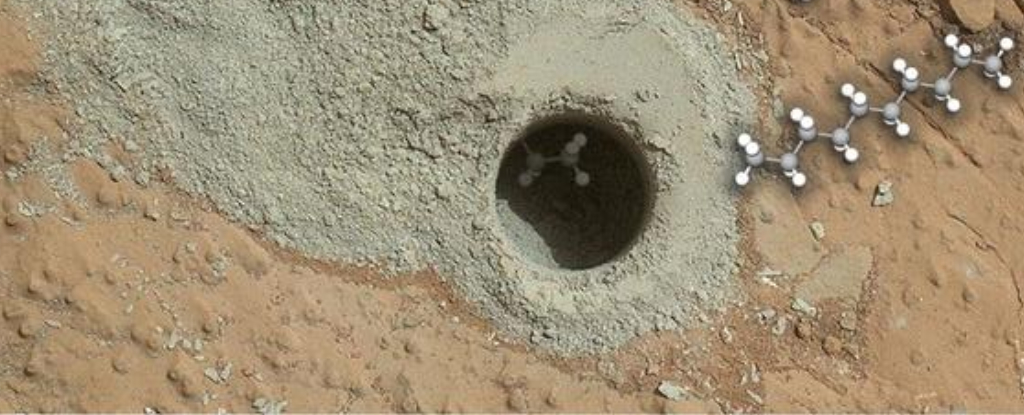In an exciting new find, researchers have discovered some of the largest carbon molecules ever observed on Mars, which has given renewed hope that life might have been possible on the Red Planet billions of years ago. The findings were made by NASA’s Curiosity rover, which has been examining the surface of Mars and returning useful data from an ancient lake bed in Gale Crater.
The molecules are carbon chains up to 12 atoms long and are among the largest hydrocarbons discovered so far on Mars. The discovery is important because big carbon molecules, such as decane, undecane, and dodecane, are the kind of organic molecules that would suggest life, although they can also be created abiologically. That the chemicals exist in rocks on Mars implies that the planet had conditions in the past that could have been capable of sustaining life.

Gale crater on Mars, with mudstone drill site circled. (NASA)
Curiosity’s drilling missions, aimed at pulling samples out of Martian rock formations millions of years old, have taken us closer to Mars’ ancient past. The fresh examination of the Cumberland mudstone deposit, a sedimentary rock formation at Gale Crater, yielded these intricate carbon molecules. The find adds to decades of research and supports the expanding theory that Mars may have been more welcoming in the distant past, perhaps even able to sustain life.
The researchers employed sophisticated methods, including gas chromatography-mass spectrometry, to painstakingly analyze the samples. The process entails heating the rock samples to high temperatures to extract organic compounds, which are then analyzed in detail for structure. The finding of these long, linear carbon molecules is different from earlier discoveries, which were more small, aromatic compounds, more characteristic of stable organic structures.

The Curiosity rover with an image of its Sample Analyzer on Mars instrument case, which tests material from the planet’s surface. (NASA/JPL-Caltech/MSSS)
Although scientists are careful, since these molecules may be produced non-biologically, their occurrence in the Martian rock of eons ago keeps alive the interesting possibility that Mars had life. These molecules in our world usually occur in living organisms, and thus the connection to life becomes even more fascinating.
Although we can’t yet definitively answer if life ever did develop on Mars, this find provides us with a glimmer of hope and a purpose to continue searching. With missions set for the future, researchers are anxious to get in and determine if Mars ever did host life in some form. This discovery contributes to the mounting evidence that Mars could have been much more than a desolate, arid world in the distant past—it could have been a planet where life thrived.




